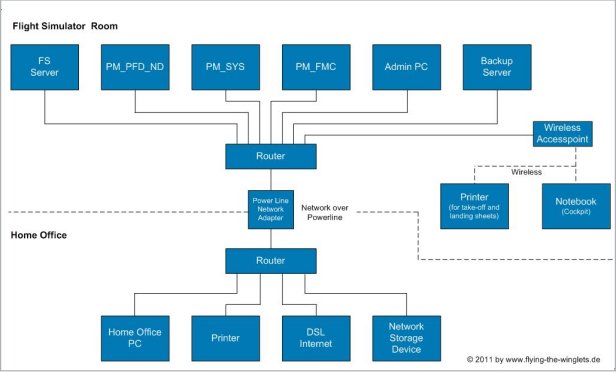IT & Network
Introduction
The physical setup of the IT and network structure is
not a big deal, however it is always helpful to have a
plan and possible further extension should already be
considered. To get the required connectivity you might
find some hurdles on the way, especially with firewalls
and their configuration.
IT & Network Configuration
The IT & network configuration is straight forward.
The network of the flight simulator room and the home
office are separated as good as possible. A complete
separation was not possible due to the jointly
used internet access and of a network storage device. The
network storage device acts as interface for flight
plans, which I usually prepare off-line on the home
office PC. With the power-on the flight simulator room,
a script, installed on the Admin-PC, fetches the flight
plans from the network storage device and deploys them
to specified directories (fsplan and IVAO) of the FS
Server.

IT & Network configuration of the flight simulator
room with connection to the home office network and
internet. All network components have a fixed TCP/IP
address.
Click the item to expand the
illustration

The bottleneck is the network path over the power line. However, it is within an acceptable range. The net data rate varies typically around 25 MB / sec. This is absolutely sufficient for data and voice communication during on-line flying.
One of the challenge with the network is the policy for file and directory access rights. The easiest way is to grand full access right for everyone. But you can't have the cake and eat it, too. Full access right for everyone inherent high security risks. So the best way is to grand access right for specific user.
Connectivity Test
Once the physical connectivity is set up and tested with
simple ping commands on the WINDOWS command level
interface, the next step is to check the connectivity on
application level. This will show whether
all necessary ports are open and access rights are
granted as required by the applications. This test is
more difficult and typically requires that the
applications are running. The tests have to be
performed on function level.
For a check of the Project Magenta requirements regarding access rights 'pmfilecheck.exe' is very helpful. The utility is provided on the PM website.
Information Security
Information security is a broad field and applies to
computers and networks. Typically it involves the
following aspects:
- Confidentiality
- Integrity
- Availability
What does it means to a flight
simulator installation? No matter how big/extensive/complex
the flight simulator installation might be, some basic
security measures should be implemented.
I have implemented the following measures:
|
- No
installation of Office programs and mail
clients on any of the flight |
Tip:
No automatic hotfix update,
because this could cause to an emergency
situation during a flight. Happened once to me, when
one of
the computers
did an automatic reboot as last step of the update procedure.
WIDEFS, AES Remote, and Open Cockpits IOCP server need some open
ports for their communication:
|
- WideFS use port 8002 as
default primary port
- IOCP server
port by default 8092 |
Depending on the used firewall a requester will pop
up and ask you to confirm the port usage. If not,
use the expert mode of the firewall and set it
manually.